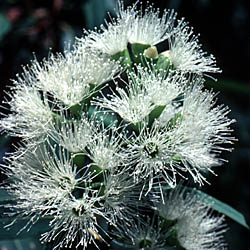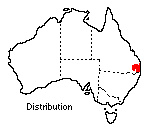Eucalyptus curtisii
 |
Plunkett Mallee
Eucalyptus curtisii Blakely & C.T.White
In the Australian National Botanic Gardens Eucalyptus curtisii has shown itself to be an ideal garden specimen. The plants are a fine sight in December or January when large clusters of whitish flowers cover the tops of the branches.
The common name Plunkett Mallee (E. curtisii) derives from the area where the plants grow. The species is only found growing naturally in a restricted area about 60 km south of Brisbane near Plunkett.
 In
its natural habitat it forms a mallee-like shrub or small tree 2 - 7 m high.
The main distinguishing character of mallees is their lignotuber - a swollen
mass of woody tissue that occurs at ground level from which a number of thin
stems arise.
In
its natural habitat it forms a mallee-like shrub or small tree 2 - 7 m high.
The main distinguishing character of mallees is their lignotuber - a swollen
mass of woody tissue that occurs at ground level from which a number of thin
stems arise.
Myrtaceae, the family to which Eucalypts belong, is a group of very attractive, adaptable and hardy plants suitable for cultivation in a wide range of situations. E. curtisii has proved to be frost resistant and easily cultivated in the Canberra climate.
Mature leaves are alternate or occasionally opposite, 6 - 13 cm long and 10 - 25 mm wide. These lanceolate leaves are shiny green above and pale underneath. Lateral veins mark an angle of 50° - 60° to the midrib. Only a few oil glands are present in the leaves and even when crushed the leaves are only slightly aromatic. The smooth, silvery grey bark sheds in long ribbons. Flowers are borne in large corymbose panicles. Individual flowers are 2 cm across with the colourful constituents being the numerous stamens. Fruits are bell-shaped, 7-8mm in diameter and appear in large clusters. When ripe, the brownish coloured seeds are released from their capsules. Seed germinates readily and this is the best method of propagation.
Many Eucalypts are attacked by leaf-eating pests and scale. Eucalyptus curtisii is disfigured by these leaf chewers, but they are easily controlled with an application of a suitable insecticide. Scale, if it presents a problem, is best controlled during October to November when young crawlers appear. Spraying with white oil during this time of the year usually provides control. For older mature scale it may be necessary to use a mixture of white oil and a suitable insecticide. Contact a qualified horticultural adviser for recommendations.
Text by ANBG staff (1975)
Name meaning: Eucalyptus curtisiiEucalyptus - a Greek compound from Eu, well, and calyptos or kalyptos, veiled or covered alluding to the calyx and/or petals which form a lid over the flower bud; curtisii - after Densil Curtis, who first drew attention to
the tree when collecting in its locality in 1923 |
![An Australian Government Initiative [logo]](/images/austgovt_brown_90px.gif)

